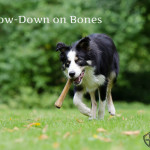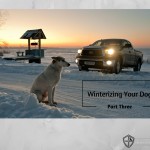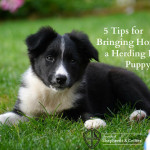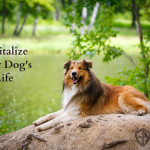Winterizing Your Dog, Part 1
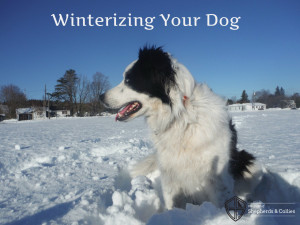
When most of us think about preparing for Winter, our thoughts turn to a new down coat, buying enough firewood (for those lucky enough to have a fireplace!) and snow tires. It’s easy to forget that our furry friends need a little preparation, too! Whether long or short-haired, young or old, it is essential that our dogs go into the season prepared. Through this three-part series, you can learn how to keep your dog happy, healthy and warm.
Different Coats Mean Different Needs
Just like people, dogs come in different shapes, sizes and body types. One additional consideration for them is their coat types. From hairless to incredibly dense, the variations in fur are nearly endless.
While many of the herding breeds have long, thick coats that are adequate for limited winter exposure, there are a few exceptions that may need a little extra pampering during the cold months. Dogs such as Cardigan Welsh Corgis, Belgian Malinois, Smooth-coated Collies, Kelpies and Canaan dogs have shorter, less dense coats, making them more susceptible to the cold. No dog should be left outside for extended periods of time during extremely frigid weather, regardless of how much fur they have, but it’s essential to take extra care to protect the short-haired breeds from inclement conditions.
Rule number one for ANY dog (even our heavy-coated herding breeds), is to not leave them outside when the weather is cold. Just like us, they have a limited defense against frigid temperatures. This is doubly important for the short-haired breeds. It would be somewhat akin to us putting on a windbreaker over a t-shirt to go out in a blizzard. For dogs with longer, thicker coats, they may have a slightly longer cold tolerance, but they can still quickly become hypothermic in extreme cold. Keeping all of this in mind, some of the heavy-coated herding breeds are actually comfortable outside without a jacket or boots for extended periods of time, but it is very important to pay attention to his or her behavior and communication with you. Your dog will give you cues as to when it's time to go back indoors to warm up.
Turning Up The Heat
There are several ways you can keep your pup from feeling the chill and help him stay warm through the winter months. The less the body has to work to keep him warm, the stronger all his systems will be, including his immune system.
Canine fashions have come a long way in the last ten years. From the ridiculous to the downright utilitarian, it’s easier than ever to find quality clothing specially designed to fit your dog perfectly and provide warmth through the cold months.
Although your dog may not like it, a good quality jacket is the first line of defense against hypothermia. Make sure it fits well and is snug (not tight), to keep his body heat in. If you’re not sure about how to fit your dog, most pet stores can provide you with guidance. The labels on most will provide general measurements for sizing. If your dog is lacking in belly hair, look for one with a wide panel that wraps around their abdomen and chest, between their front and back legs. (Please note that even if you do keep your dog in a coat, he should not be left outside for any period of time in the snow or cold.) Elderly dogs and puppies, or those with compromised health need special consideration when exposed to weather extremes. Even heavy-coated dogs that are aged or very young could benefit from a jacket to keep them from becoming hypothermic.
Sweaters are also a great way to keep your shorthaired dog warm indoors. If your house has drafts or the thermostat is kept low for energy conservation, it’s safe to say if you feel the need for a sweater, your dog could probably benefit from one, too. Choose a sweater that is soft, has a fairly tight weave (the looser the weave, the easier it is for it to become snagged and pulled) and is washable. Be sure that it fits well so he doesn’t become bound up in it on accident. Just like our clothing, theirs can benefit from regular washing. Follow the care instructions on the label, and it should last the duration of the season.
If your dog likes to venture outside a lot during the winter, it’s a good idea to invest in a pair of dog boots with heavy, slip-proof tread. Unfortunately, it seems Uggs has yet to start making boots for dogs. Despite the lack of style, there are some really great mid-range dog boots on the market. Luckily, the past few years have seen many advances in designs for fit and function. It’s easy to find kicks for your dog that will fit them well and protect their feet from compacted snow between the pads, cuts, abrasions, chemical exposure and frigid cold.
Another way to protect your pal from the icy fingers of winter is by providing them with a warm, well-insulated bed. The floor can be one of the coldest parts of the house, so by placing a thick layer between it and your dog, you’re ensuring that he is being protected while he sleeps. There are even orthopaedic beds on the market that contain heating elements, much like those in electric blankets, or heat retention layers that utilize your pet’s own body heat to maintain a warm sleeping environment. These are especially nice for older dogs suffering from arthritis.
To Clip Or Not To Clip?
If your dog is anything like mine, his or her fur, no matter how often brushed, can become a matted nightmare. Aussie shepherds and collies in particular seem to have coats that just won’t quit. It’s tempting to forego the regular sessions with the Brush of Torture, or frequent visits to the grooming shop for a bath and brush-out in favor of a good clipping, but it might be a wise idea to allow your dog to grow his full coat out if you live in a cooler region. Dogs have amazingly fine-tuned thermoregulation systems, and messing with this balance by clipping or complete shaving can spell disaster.
If you MUST clip (for example, your dog is regularly working sheep or cattle in muddy pastures), be sure you have an adequate waterproof and insulated jacket for him to wear outside and a sweater for indoors. There are many designs available on the market that won’t impede movement, and as long as he isn’t ducking under a lot of brush or barbed wire, a jacket shouldn’t get in the way. You can also consider only clipping the areas that can be compromised by the mud and snow. This would include the underbelly and feathers along the legs.
Also, be sure when your dog comes in to dry his legs, feet and underbelly thoroughly with a towel. Most herding breeds have “double coats,” meaning that they have a dense, fuzzy undercoat that acts as a layer of insulation, protected by the outer coat - a more course, smooth type of hair that helps repel water and act as a sort of rain slicker, if you will, keeping the downy undercoat dry. When clipped, the outer protective coat is compromised, allowing moisture to easily work its way down to the skin level.
Adequate Nutrition
If your dog seems to be flagging a little in the colder weather, it may be time to revisit his diet. His dietary needs during the winter may vary from those during the warm months. Typically, an increase in fat and protein can help add the extra calories and energy he needs to navigate through the cold months with ease. The body burns this “fuel,” if you will, allowing the generation of body heat. If there is not an adequate caloric intake, this process can be slowed, making it harder for your dog to produce enough body heat to stay adequately warm. It’s kind of like running out of coal for the furnace; the small bits left will keep up a slow burn, but won’t produce any significant warmth. As with any change, it’s best to consult your veterinarian before making any major changes to your dog’s diet, and especially if he’s medically compromised in any way.
Please watch for the next segment of this series! It will offer advice on how to protect your pets from the unseen hazards of winter, the best way to prevent winter poisonings, winter travel with your dog and more!
Article By:
Jennie Eilerts


